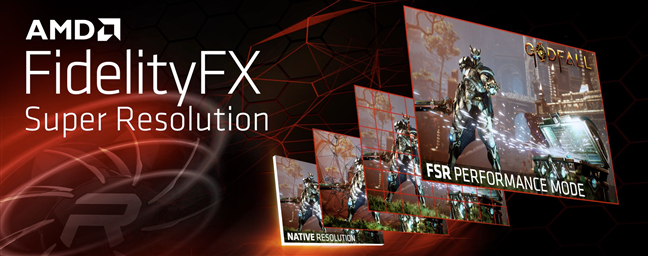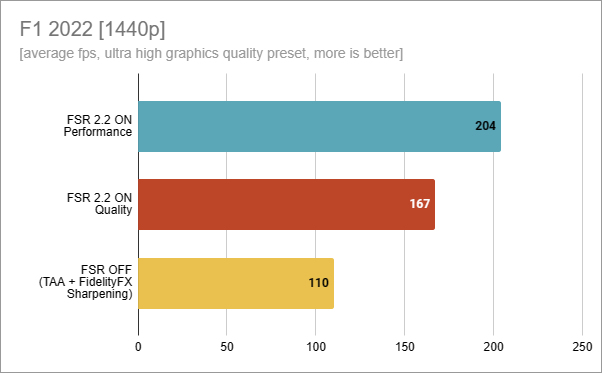What is AMD FidelityFX Super Resolution (FSR) and how does it work?

Have you come across the term AMD FSR on the internet or maybe somewhere in your favorite game’s graphics settings? Are you wondering what AMD FSR is? Or maybe you want to enable FSR, but you’re not sure if your graphics card is on the AMD FSR-supported GPU list? If you want to understand the reasons behind this technology, why you might want it, and how to enable it, you’re in the right place. Plus, I’ll share quite a bit of info regarding the things you get from each version of FSR, including the cool stuff that the latest AMD FSR 3 can do. If you’re interested, keep reading:
What is AMD FSR (FidelityFX Super Resolution)?
If you’ve played games in the last couple of years, you’ve definitely heard about AMD’s FSR. FSR comes from FidelityFX Super Resolution and it’s an upscaling and frame generation technology created by AMD that helps improve the framerate in supported games. FSR works by rendering the game at a lower resolution and then upscaling the image to make it look sharper. Plus, newer versions of AMD FSR like FSR 3 and FSR 3.1 can also use AI (artificial intelligence) to create additional frames between the ones your computer renders. While some quality can be lost along the way, the advantage is that you get a higher and more stable framerate in your favorite games without having to invest in an expensive graphics card you can’t afford.

AMD FidelityFX Super Resolution
AMD FSR is an open-source solution that developers can implement in any game, and it works regardless of whether you’re using an AMD, Intel, or NVIDIA graphics card. This has helped AMD’s FSR become a technology that’s rapidly adopted by game creators. Let’s take a look at what each AMD FSR version introduced:
AMD FSR 1: Introducing upscaling for increased performance
Launched in June 2021, the first version of FSR used a technique called spatial rescaling. This method analyzed each game frame to find edges and then improved them to make the image look clearer. It also added sharpening to make the upscaled frames look better and more detailed.


How AMD FidelityFX Super Resolution version 1 works
AMD FSR 2: Shifting to temporal upscaling to improve image quality
Since the release of FSR 2.0 in May 2022, AMD FSR is no longer just a spatial upscaling solution, but a temporal one. What does that mean? Instead of only enhancing edges in frames, FSR 2.0 and later versions analyze the frame(s) that were rendered just before the current one. By doing this, FSR can learn about the color depth and movement vectors from past frames and use that information to upscale the next ones. The result is better image quality compared to AMD FSR 1.


AMD FidelityFX Super Resolution 2.0
In September 2021, AMD FSR 2.1 came out with further enhancements to image quality, reducing ghosting and improving color range, and the list of games supporting FSR kept getting longer. Then, AMD released FSR 2.2 in December 2022, featuring even more improvements in image quality, especially by reducing ghosting on fast-moving objects. This makes the tech more useful in high-speed games such as car racing titles.
AMD FSR 3: Bringing frame generation to everyone
Getting closer to the present day, AMD introduced FSR 3 in September 2023, taking a huge leap forward by including frame generation technology. FSR 3 not only upscales rendered frames like previous versions, but also creates entirely new frames between those that are rendered. This boosts the framerate a lot, but it doesn’t put too much strain on your graphics card (GPU). Essentially, AMD FSR 3 analyzes previous frames to generate predictive frames, providing a smoother visual experience, especially in games with lower native framerates.


AMD FidelityFX Super Resolution 3
In addition, AMD improves the temporal stability of FSR 3, meaning that details in fast-moving scenes are more consistent, reducing the presence of artifacts. This is a major improvement and ensures that you get higher framerates, while still managing to maintain good image quality.


How AMD FidelityFX Super Resolution version 3 works
AMD’s frame generation feature, also called AMD Fluid Motion Frames, is the company’s response to NVIDIA’s DLSS 3 and is particularly great for games with demanding graphical effects such as ray tracing, but not only. Games like Cyberpunk 2077, Starfield, Avatar: Frontiers of Pandora, and Star Wars Outlaws are among the ones to adopt AMD FSR 3, showcasing impressive performance boosts. With FSR 3, you can expect up to a two-time increase in framerate and a top-notch gaming experience even at high resolutions like 1440p or 4K.


Games supporting AMD FSR 3
Similar to its predecessors, AMD FSR 3 remains an open-source solution, which means it supports AMD, Intel, and NVIDIA graphics cards, unlike NVIDIA’s proprietary DLSS technology. This open approach is why FSR continues to see widespread adoption in games of all types. FSR 3 is compatible with a wide range of GPUs, including AMD Radeon RX 6000 series, AMD Radeon RX 7000 series, NVIDIA GeForce RTX 20 series, NVIDIA GeForce RTX 30 series, NVIDIA GeForce RTX 40 series, and even Intel Arc GPUs.
AMD FSR 3.1: Decoupling frame generation from upscaling
FidelityFX Super Resolution (FSR) 3.1 is a big step up from its earlier versions, yet again bringing some impressive improvements in how it generates frames and enhances image quality. By using more advanced techniques for temporal data and motion vectors, FSR 3.1 can interpolate frames more accurately, and the result is a smoother and more natural gameplay. Common issues like ghosting and shimmering are further reduced compared to AMD FSR 3.0, especially during fast-paced action, while also minimizing lag and stutter. But the greatest thing about AMD FSR 3.1 is its ability to separate frame generation from upscaling.


Ghost of Tsushima supports AMD FSR 3.1
This decoupling offers greater flexibility and boosts performance, allowing games to run at higher framerates even when upscaling isn’t needed. It also means that you can use AMD FSR 3.1 frame generation tech together with other upscaling solutions, like NVIDIA DLSS or Intel XeSS.
So, not only does AMD FSR 3.1 make your games look better with higher quality images, but it also gives you higher frame rates on pretty much any hardware, regardless of whether it’s coming from AMD, NVIDIA, or Intel. It’s something that NVIDIA can’t say about its tech…
AMD FSR presets: What resolutions are used for upscaling?
AMD’s FidelityFX Super Resolution upscaling technology allows developers to implement any quality preset, but the company recommends six standard ones. Each of the standard quality presets has a different scaling factor and render scale. Here are the presets you’ll likely find in your favorite game’s settings:
- Native AA: Available exclusively in games that support AMD FSR 3. It functions purely as an anti-aliasing option without any upscaling. When used alongside Frame Generation, it allows for frame generation without any upscaling involved.
- Ultra Quality: Available in games that support AMD FSR version 1.0 only; it uses a scale factor of 1.30x and a render scale of 77.0%.
- Quality: Can be implemented in games that support any AMD FSR version; it uses a scale factor of 1.50x and a render scale of 66.6%.
- Balanced: Found in every game that supports any AMD FSR version; it uses a scale factor of 1.70x and a render scale of 58.8%.
- Performance: Available in games compatible with any AMD FSR version; it uses a scale factor of 2.00x and a render scale of 50.0%.
- Ultra Performance: Optionally available in games that support AMD FSR 2.0 or later, depending on the developer’s implementation. It uses a scale factor of 3.00x, rendering at 33.3% of the target resolution.


AMD FSR 3.1 upscale quality presets in Horizon Forbidden West
The input resolution used by a game with AMD FSR depends on the resolution you choose in its settings and the FSR image quality preset you select. For example, if you set your favorite game to run at a 1440p resolution of 2560 x 1440 pixels and select the Ultra Quality FSR preset, then the input resolution of AMD FSR (the one your computer actually renders frames in) is 1970 x 1108 pixels. That’s 77% of the 2560 x 1440p resolution you’ve set the game to use.
What games support AMD FSR?
I’ve already mentioned a few games, but honestly, the full list is very long. As of now, there are about 106 games that either support or are about to support AMD FSR 3 or FSR 3.1.


Over 100 games are compatible with AMD FSR 3.1
On top of that, there are also 183 games compatible with FSR 2, 2.1, or 2.2. And I am not even mentioning older games that support AMD FSR 1.


There are almost 200 games supporting AMD FSR 2.x
If you want to check out the complete list of games that support AMD FSR, you can find it here: Latest AMD FSR 2 & 3 Supported Games List.
Which graphics cards (GPUs) support AMD FSR?
Another interesting thing about AMD’s FidelityFX Super Resolution is that, being open-source, it doesn’t only work with the company’s own graphics cards but also with the ones from its competitors, NVIDIA and Intel. NVIDIA even has a 180-degree opposite stand on the matter, as its DLSS upscaling technology is closed and only works with its own GPUs. AMD deserves huge kudos for the way it handles FSR!
And the even better news is that AMD FSR can be used on almost any graphics card released in the last six years or so. The list includes but is not limited to all the following generations of graphics cards from both AMD and NVIDIA:
- AMD Radeon 7000 series
- AMD Radeon 6000 and 6000M series
- AMD Radeon 5000 and 5000M series
- AMD Radeon VII, RX Vega, 600, 500, RX 480, RX 470, and RX 460 series
- NVIDIA GeForce RTX 40, RTX 30, and RTX 20 series
- NVIDIA GeForce 16 and 10 series
- Intel Arc A and B-series


An AMD Radeon RX 7900 XT GPU that works great with AMD FSR
If you want to use AMD FSR 3 with both upscaling and frame generation, however, AMD recommends having:
- An AMD Radeon RX 6000 series or newer graphics card, or
- An NVIDIA GeForce RTX 30 series or newer graphics card
If you have one of the recommended graphics cards, you get the best performance and visuals. Still, that doesn’t mean you can’t still enjoy AMD FSR 3 even if you have a slightly older card. However, you should at least use an AMD Radeon RX 5000 series or an NVIDIA GeForce RTX 20 series. Regarding Intel graphics cards, AMD has no recommendations or minimum requirements specified on its websites.
How to turn FSR on or off
Based on your intuition, you’ve probably already guessed how to enable AMD FSR. It’s done directly from your favorite game. And you can only enable AMD FSR in a game that supports it. As for where exactly in a game you find the switch for turning on AMD’s FidelityFX Super Resolution and selecting a quality preset, I can’t pinpoint that exactly. It depends on the game and on design choices.
However, the options for AMD FSR and frame generation are usually found somewhere in the game’s video or graphics settings. For example, in Starfield, you’ll find them in:
Settings > Display > Upscaling > FSR3
and
Settings > Display > Frame Generation > ON


How to turn on FSR in Starfield
As another example, in Cyberpunk 2077, you can enable AMD’s FidelityFX Super Resolution and frame generation in:
Settings > Graphics > Resolution Scaling > AMD FidelityFX Super Resolution 3
and
Settings > Graphics > Frame Generation > AMD FSR 3 Frame Generation


How to turn on FSR in Cyberpunk 2077
Do you enjoy AMD FSR upscaling and frame generation tech in your favorite games?
Without a doubt, AMD FSR is extremely useful, and each new version keeps getting better. With the introduction of AMD FSR 3 and its frame generation capabilities, the technology is now theoretically on par with NVIDIA’s DLSS 3. Furthermore, I am thrilled with the high number of games supporting it, and the list is constantly getting longer. Before closing this article, I’m curious: What’s your opinion about AMD’s FidelityFX Super Resolution technology? Do you use it, and if you do, in which games? Are there any games you love that aren’t yet compatible with AMD FSR? Let me know in the comments below.
Source link






